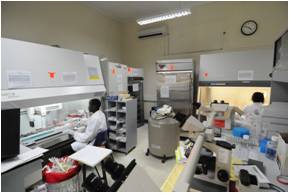USAMRU-K Kisumu Field Station
Malaria Drug Resistance (MDR) and Entomology Laboratory 
Overview. The MDR laboratory conducts surveillance of antimalarial drug resistance profiles through in vitro susceptibility testing and molecular marker analysis. In addition to generating valuable epidemiological data, these efforts support KEMRI/USAMRU-K clinical trials and provide timely information to Kenya public health authorities to inform antimalarial drug policy decisions.
MDR laboratory staff consists of a Principal Investigator, senior research officer, research officer, two assistant research officers, and a laboratory technician. The MDR laboratory is funded by the DoD GEIS program. MDR’s annual budget is approximately $300K. The MDR laboratory is located on the KEMRI/CDC campus in Kisian, about six kilometers west of Kisumu. The MDR laboratory, housed in three laboratory rooms, is equipped with refrigerators, -80C freezers, biosafety cabinets, incubators, a liquid handling robot, a five-head teaching microscope, a microtiter plate fluorometer, a polymerase chain reaction (PCR) machine, high-speed internet, and backup electrical power.
The MDR laboratory tests Plasmodium parasites, the causative agent of malaria, collected from volunteers diagnosed with malaria, for resistance to commonly used therapeutic and prophylactic antimalarial drugs. The MDR laboratory has been collecting and testing malaria parasites for seven years, and has accumulated an extensive library of samples and data on malaria drug resistance patterns across Kenya.
Living parasites are tested in vitro by culturing them with a panel of six to 12 antimalarial drugs to measure the ability of the drugs to prevent the parasites from growing. The drug panel includes chloroquine, mefloquine, quinine, artesminin, amodiaquine, and doxycycline. Since 2008, parasite growth inhibition has been measured using an improved fluorescent SYBR Green assay. The assay takes about three days to complete. The KEMRI/USAMRU-K MDR laboratory is the first in East Africa to have successfully implemented the assay. Additionally, the laboratory is the first to perform in vitro drug sensitivity testing on parasites that are not previously adapted to in vitro culture. This advancement promises data that more accurately reflects the parasite phenotype in vivo.
Parasite DNA is also tested by polymerase chain reaction (PCR) to detect genetic mutations linked to antimalarial drug resistance. Genes testing include PfMDR1, linked to mefloquine and artemisinin resistance, PfATPase6, which is suspected of being linked to artemisinin resistance, and PfCRT k76, which is linked to chloroquine resistance. The PCR assays may be performed on a small blood blot dried on filter paper, and can be performed in under one day. These assays may lead to high-throughput testing to more broadly estimate malaria drug resistance profiles.